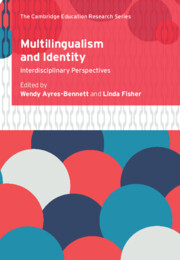Book contents
- Multilingualism and Identity
- Multilingualism and Identity
- Copyright page
- Contents
- Figures
- Tables
- Contributors
- 1 Towards Interdisciplinarity in Multilingual Identity Research
- Part I Situated Multilingualism and Identity
- Part II Multilingual Identity Practices
- Part III Multilingual Identity and Investment
- 13 Multilingualism(s), Globalization and Identity
- 14 Who Are the Multilinguals?
- 15 Multilingual Identity Construction through Participative Reflective Practice in the Languages Classroom
- 16 Young Children’s Language Attitudes with Implications for Identity in a US Dual-Language Immersion Classroom
- 17 Language, Identity and Empowerment in Endangered Language Contexts
- 18 Afterword
- References
- Index
14 - Who Are the Multilinguals?
Pupils’ Definitions, Self-Perceptions and the Public Debate
from Part III - Multilingual Identity and Investment
Published online by Cambridge University Press: 22 July 2022
- Multilingualism and Identity
- Multilingualism and Identity
- Copyright page
- Contents
- Figures
- Tables
- Contributors
- 1 Towards Interdisciplinarity in Multilingual Identity Research
- Part I Situated Multilingualism and Identity
- Part II Multilingual Identity Practices
- Part III Multilingual Identity and Investment
- 13 Multilingualism(s), Globalization and Identity
- 14 Who Are the Multilinguals?
- 15 Multilingual Identity Construction through Participative Reflective Practice in the Languages Classroom
- 16 Young Children’s Language Attitudes with Implications for Identity in a US Dual-Language Immersion Classroom
- 17 Language, Identity and Empowerment in Endangered Language Contexts
- 18 Afterword
- References
- Index
Summary
How multilingualism and related concepts are seen, is likely to influence who identifies as multilingual. This chapter examines views of multilingualism in education in Norway. Based on an overview of prevailing definitions of multilingualism and the presentation of Norway as a multilingual country, I discuss the extent to which multilingualism is seen as a resource in the curricula for selected language subjects, white papers on education, the work of scholars researching multilingualism, and Norwegians in general. These understandings are compared to pupils’ own definitions of multilingualism and to what extent they identify as multilingual. The analysis shows that positive attitudes towards multilingualism are widespread in society and in policy papers on education. However, not all types of multilingualism are equally embraced, since migrants’ multilingualism is often discussed in problem-oriented terms. Furthermore, scholars in Norway refer mainly to migrants in multilingualism discourse, thus excluding most people living in Norway from identifying as multilingual. However, secondary school pupils’ own definitions and self-perceptions take a broader and more inclusive approach.
- Type
- Chapter
- Information
- Multilingualism and IdentityInterdisciplinary Perspectives, pp. 281 - 298Publisher: Cambridge University PressPrint publication year: 2022
- 12
- Cited by

